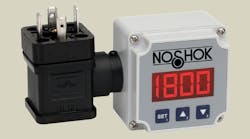Those working in the fluid power industry often consider themselves mechanically inclined. Concepts of pressure, force, flow, and torque are second nature. But the continuing influx of electronic components — especially transducers — into hydraulic and pneumatic systems makes knowledge of electrical terminology and concepts essential to job performance.
Download FAQs on Electronic Pressure Transducers sponsored by NOSHOK to help explain some of the most common concerns surrounding pressure sensors, we present some common questions and direct answers.


